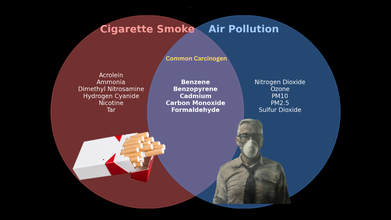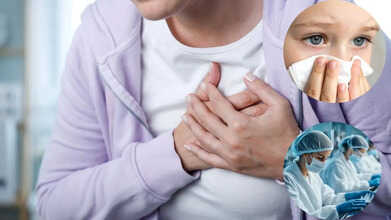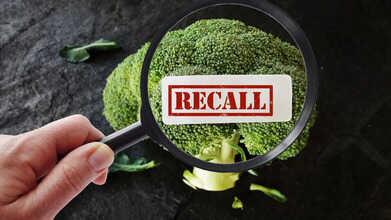- Health Conditions A-Z
- Health & Wellness
- Nutrition
- Fitness
- Health News
- Ayurveda
- Videos
- Medicine A-Z
- Parenting
Jeremy Clarkson Opens Up About His Health And Extreme Diet, ' If It’s Got More Than One Ingredient In It, Don’t Eat It.”

Credit-Getty Images
Jeremy Clarkson is back for another season of ‘Who Wants To Be A Millionaire?’ and he's opening up about the changes he's made to his lifestyle to improve his health following a serious health scare. The beloved show host explained how he had to go on a very strict diet because one of the arteries that supplies blood to his heart was completely blocked. Such a blockage can only be fixed with surgeries and takes a massive toll on one's body.
In an interview with the Metro, he revealed that last October, he was hospitalized due to chest tightness, which led to the discovery of a completely blocked artery. When cases like this arise, the routine surgery includes unclogging the artery and placing a stent, a small, expandable tube that's inserted into a blood vessel or duct to keep it open. It makes sure it does not happen again. This was a big wake up call for him, and he decided to take his body and health more seriously, making healthier lifestyle changes. The doctors had also told him that he was just a few days away from worsening his condition, which could have meant long-lasting damage to him.
This is often the case for many people, most of us think that nothing bad would happen to us with a slight lifestyle changes. However, when it does, it may come to us like a big shock. It could also be the alarm that we needed to remind ourselves to take better care of our health. This is what happened with Clarkson, he consulted a dietician who advised him to eliminate processed foods from his diet. "If its got more than one ingredient in it, don’t eat it" is what he was told, and he took it very seriously.
What Lifestyle Changes Did He Have To Make?
He’s swapped previous snacks like bacon for healthier alternatives such as celery and carrots. Jeremy shared that he even received notifications from his phone about eating fewer sausages and taking fewer steps, which he jokingly attributed to sitting during the show's taping. However, he emphasized that he feels much better since implementing these dietary changes and credits the health scare with giving him the necessary motivation to prioritize his wellbeing. He compared this to quitting smoking after a bout of pneumonia, stating that these experiences provide a stark realization of the need for change.
Signs Of Artery Blockage You Should Look Out For
Chest pain can be scary because it has two meaning: a blocked artery (called angina) or a heart attack. Knowing the difference is important. Angina is a symptom of an underlying heart condition that causes chest pain or discomfort. It's usually caused by a partial blockage or spasm in the arteries that supply blood to the heart. It usually happens when you're active or stressed and goes away when you rest. But the pain that causes heart attack doesn't stop even when you're resting. Angina isn't a disease itself, rather a sign that could lead to serious heart diseases.
The pain can start in your chest and spread to your arm, shoulder, jaw, or back. Other signs of blocked arteries can be dizziness, feeling weak, a fast or fluttering heartbeat, feeling sick to your stomach, sweating, and trouble breathing. Knowing these signs can help you get help quickly.
Chest Pain (Angina) vs. Heart Attack
Chest pain can signal both a blocked artery, another word for which is angina or a heart attack. The key difference is that angina pain subsides with rest, while heart attack pain persists.
Angina Pain Characteristics
Angina, a symptom of conditions like coronary artery disease, often starts in the breastbone and can spread to the left arm, shoulder, jaw, or upper back.
Other Atherosclerosis Symptoms
Besides chest pain, other signs of blocked arteries include dizziness, weakness, heart palpitations (racing or fluttering heart), nausea, sweating, and shortness of breath.
Breathing Delhi's Toxic Air Is Like Smoking 20 Cigarettes A Day, According To Pulmonologist

Credits: Canva, PTI
As of 7am today, Delhi's average AQI was registered at 446 as per aqi.in. However, the Early Warning System for Delhi, under the Ministry of Earth Sciences, Delhi's average AQI at 7am was registered at 341, slightly better, still close to 400. Dr Shivanshu Raj Goyal, a pulmonologist and Associate Director Pulmonary Medicine at MAX Healthcare in Gurugram and Delhi, in an Instagram video said that breathing this toxic air is equivalent to smoking 20 cigarettes in a day.
No One In Delhi Is A Non Smoker
The doctor starts his video with a rather strong statement, "At present, no one in Delhi-NCR is a non-smoker."
"With the AQI of around 400, if I break down the facts, with every 20 of an AQI of PM2.5, is equivalent to smoking a cigarette. So at the AQI of around 400, you are smoking easily 20 cigarettes a day. That is for everyone, each one of us, even a small change. So imagine the amount of damage that this AQI must be causing to your lungs," he says.
The doctor also states that on an average, a person breathes around 20,000 times in a day, so it means we are inhaling the toxic air at least 20,000 times a day.
As per Action on Smoking and Health (ASH), a cigarette contains nicotine, and tar, which is composed of chemicals like benzene, benzopyrene, and the gas includes carbon monoxide, ammonia, dimethyl nitrosamine, cadmium, formaldehyde, hydrogen cyanide and acrolein. Some of these marked irritant properties are also carcinogen, meaning, it can cause cancer.
Whereas Air Pollution contains pollutants like particulate matter PM 10 and PM 2.5, ozone, nitrogen dioxide, carbon monoxide, cadmium and sulfur dioxide. Air pollution, which is often a byproduct of combustion or released from vehicle exhaust also contain formaldehyde, benzopyrene, and benzene. As per the World Health Organization (WHO), the pollutants contain carcinogens, and the outdoor air pollution is in fact classified as Group 1 carcinogen.
Common Carcinogen In A Cigarette And Air Pollutants

Carbon Monoxide: a poisonous, flammable gas that is colorless, odorless, tasteless, and slightly less dense than air.
Benzene: a colorless and highly flammable liquid with a sweet smell, and is partially responsible for the aroma of gasoline.
Cadmium: a soft, silvery-white metal (atomic number 48) that is toxic and naturally found in the environment, but human activities have increased its levels. It is used in products like batteries, pigments, and coatings, and exposure can occur through tobacco smoke, contaminated food, and occupational inhalation. Cadmium is a known human carcinogen that can damage the kidneys and bones.
Formaldehyde: a colorless, flammable gas with a strong odor, whose exposure could cause cancer.
Benzopyrene: a group of organic compounds known as polycyclic aromatic hydrocarbons. It is a colorless crystalline solid found in sources like cigarette smoke, coal tar and is a known carcinogen that can cause cancer and other health problems like skin rashes and bronchitis, and exposure requires medical attention for any symptoms.
So, What Can Be Done To Protect Yourself Against These Carcinogen?
Dr Shivanshu Raj Goyal points out that these carcinogens could lead to long term lung and heart damage, as well ass cause chronic cough, breathlessness, asthma, and COPD. However, there are ways to protect yourself:
- Avoid outdoor activities during peak pollution hours
- Use N95 masks when stepping out
- Keep air purifiers on indoors
- Stay hydrated and include antioxidant-rich foods
- Visit a pulmonologist if you experience persistent breathing issues
Can Catching The Flu Or COVID-19 Sharply Raise Your Heart Risk?

Credits: Canva
Contracting the flu, Covid-19, or similar viral infections can significantly raise the chance of serious heart problems, according to new research. A review of 155 academic studies by the Journal of the American Heart Association found that both influenza and Covid-19 may increase the likelihood of heart attacks or strokes by three to five times in the weeks following infection.
Catching The Flu Or COVID-19 Sharply Raises Your Heart Risk
A comprehensive review in the Journal of the American Heart Association, which analyzed 155 studies, highlighted the following short-term cardiovascular risks compared with individuals who are not infected:
Influenza (Flu): Within the first month after a confirmed infection, the likelihood of experiencing a heart attack can increase up to fourfold, while the risk of stroke may rise fivefold. The greatest danger occurs during the first week.
COVID-19: Following infection, the risk of heart attack or stroke roughly triples within 14 weeks, and this heightened risk may persist for as long as a year.
Long-Term Risks From Persistent Viruses
Viruses that last longer in the body, such as HIV, hepatitis C, and varicella zoster (shingles), may also increase the long-term risk of cardiovascular issues. Published by the American Heart Association, the study underlines vaccination as a key way to reduce these risks, particularly for those already at risk of heart disease.
Viral Infections and Heart Disease: What Is The Link?
Lead author Associate Professor Kosuke Kawai from the University of California explained: "It is well recognised that viruses like HPV and hepatitis B can cause cancer, but the connection between viral infections and other non-communicable diseases, like cardiovascular disease, has been less clear. Our research found both acute and chronic viral infections are linked to short- and long-term risks of heart attacks and strokes."
How the Study Was Conducted
The team systematically reviewed all published studies examining links between viral infections and heart attacks or strokes. Out of an initial 52,000 studies, only 155 met the strict criteria for design and quality. Findings revealed that the risk of a heart attack was four times higher and the chance of a stroke five times higher in the month after lab-confirmed influenza.
For Covid-19, individuals were three times more likely to experience a heart attack and three times more likely to suffer a stroke within 14 weeks of infection, with risks lasting up to a year.
Risks From HIV, Hepatitis C, and Shingles
People living with HIV had a 60% higher risk of heart attacks and a 45% higher chance of strokes over more than five years. Elevated risks were also observed for those who had hepatitis C or shingles.
Dr Kawai added: "While the long-term cardiovascular risks from HIV, hepatitis C, and shingles are lower than the short-term risk from influenza or Covid-19, they are still significant, especially because they last for years. Shingles alone affects about one in three people, which means a substantial number of excess cardiovascular cases at the population level."
Despite the results, the researchers noted limitations, as the study was observational rather than based on controlled trials. Nevertheless, the team highlighted vaccination as a potentially crucial tool for lowering heart-related risks.
Who Is Eligible for Flu and Covid-19 Vaccinations?
Flu shots protect against influenza, which can be life-threatening for some groups. The NHS offers these vaccines each autumn or early winter to people most at risk of severe complications.
From September 1, six primary groups were eligible:
- Secondary school children (Years 7–11)
- Children in clinical risk groups aged six months to under 18 years
- Pregnant women
- Children aged two or three years as of August 31, 2025
- Children with certain long-term health conditions (six months to under 18 years)
- Primary school children (Reception to Year 6)
- Care home residents
- Carers receiving Carer’s Allowance or main carers of elderly/disabled individuals
- People living with immunocompromised individuals
- Frontline health and social care workers
- All adults aged 65 and over
- Adults aged 18–65 with long-term health conditions
Why Are Food Recalls Suddenly Hitting US Supermarkets – Could Your Grocery Cart Be At Risk?

Credits: Canva
From ground cinnamon to breakfast burritos, popcorn, and even pet food, food recalls in the U.S. seem to be appearing more often. Does this mean our food supply is becoming less safe? According to a report by compliance firm Sedgwick, the FDA and U.S. Department of Agriculture oversaw 294 food recalls in the first half of 2025. In the same period in 2024, the FDA had ordered the destruction of nearly 85 million units. USDA recalls impacted nearly 1.5 million pounds of food, almost three times more than last year.
Is this surge a sign that food production is failing, or does it reflect improvements in traceability? Perhaps the increase is due to better public access to information, allowing more recalls to be noticed. Or is U.S. food simply more contaminated than before?
Why Are Food Recalls Increasing In The U.S.?
The growing number of recalls has left shoppers worried about the safety of groceries. Experts, however, suggest that the increase doesn’t necessarily indicate declining food quality. Instead, it largely reflects advances in detecting contamination earlier and more efficiently.
As Lena Bakovic, MS, RDN, CNSC, from Live It Up explains, “The increase in the number of food recalls that we are seeing is likely largely due in part due to improvements in detection technologies, as well as generally stricter food safety testing requirements. Combined, these advancements help to provide earlier and more effective detection of potential contamination issues.”
Rather than showing a drop in quality, these recalls demonstrate that the system is working to protect public health. Improved testing and monitoring allow potential hazards to be identified and removed from shelves before reaching consumers.
Recent Food Recalls In The U.S.
In recent weeks, a number of U.S. food recalls have caught public attention. Over six million eggs from Black Sheep Egg Company were recalled due to possible salmonella contamination, impacting multiple states. Hormel Foods pulled nearly five million pounds of ready-to-eat chicken after metal fragments were discovered in food-service shipments. About 245,000 pounds of pre-cooked pasta, linked to a deadly listeria outbreak, were also recalled, causing several illnesses and deaths.
Frozen shrimp from various brands were removed over potential exposure to cesium-137, a radioactive isotope associated with cancer risk. More than two million pounds of Golden Island pork jerky were recalled after metal contamination was traced to a damaged conveyor belt. Additionally, ready-to-eat meals from meal-kit services like HelloFresh, Blue Apron, and Marley Spoon were pulled due to possible listeria contamination, which poses heightened risk to pregnant individuals, older adults, and immunocompromised people. Consumers are advised to discard or return affected products and consult healthcare professionals if needed.
Certain Foods Carry Higher Risks
Not all foods carry the same risk of contamination. Fresh produce, for example, is vulnerable because of its exposure during growth, harvesting, and transport. Packaged “ready-to-eat” meals can also be riskier because they bypass home cooking, a step that often eliminates harmful bacteria.
As Lena notes, “Some types of food are in fact more susceptible to contamination. Raw fruits and vegetables are examples of foods particularly in danger from microbial contamination due to their fresh condition, as well as exposure to potentially hazardous environmental influences. Additionally, food products which are commercially labelled and sold as ‘ready to eat’ can become more dangerous because they skip the at-home cooking process, which would likely eliminate any harmful pathogens in the first place.”
Health Risks of Consuming Recalled Food
The health effects of eating recalled food depend on the contaminant. Bacteria like salmonella or E. coli can cause nausea, vomiting, and diarrhea, while chemical or allergen contamination may trigger allergic reactions or other toxic effects that aren’t immediately apparent.
“The health consequences can really vary depending on the root cause of the contamination,” Lena explains. “Bacterial pathogens like salmonella or E. coli can produce foodborne illnesses inducing gastrointestinal symptoms such as nausea, vomiting, and diarrhea. If a contaminant is a chemical or an allergen, allergy symptoms or other, potentially unknown, toxic effects are a possibility.”
How to Keep Up With Food Recalls
Understanding recall classifications and keeping up with alerts can help protect your family from potentially harmful products.
In the U.S., food recalls are classified into three levels:
Class I: The most serious category, used when a product poses a significant health risk and could cause severe illness or even death. Examples include foods contaminated with bacteria like Salmonella or items with undeclared allergens.
Class II: Applies to products that may cause temporary or reversible health issues. For instance, yeast or mold contamination falls under this category.
Class III: The least serious, covering minor issues that are unlikely to harm but still break regulations, such as mislabeling—like placing a watermelon-flavored item in an apple package—without allergen concerns.
To stay updated, you can sign up for notifications on the FDA website or check Recalls.gov regularly. Be aware that alerts may include non-food products, so some filtering may be needed.
© 2024 Bennett, Coleman & Company Limited

